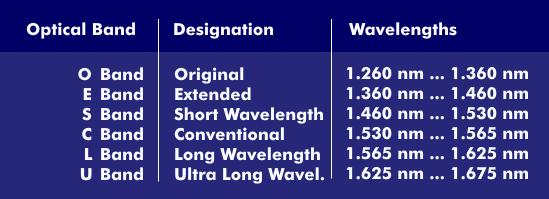telecom window
Telecommunications windows are optical transmission ranges characterized by low attenuation. They correspond to the wavelength ranges of the optical windows at 850 nm, 1300 nm and 1,550 nm. The ITU has defined three transmission or telecommunication windows with several optical bands for these wavelengths in its ITU grid.
The lowest wavelength range is that between 800 nm and 900 nm and is used for short distances and for local area networks. In this range, gallium arsenide or aluminum gallium arsenide laser diodes or light-emitting d iodes are used as light sources and photodiodes as light receivers.
The second optical window is at 1,300 nm and is characterized by lower attenuation and chromatic dispersion compared to the 800 nm window. In this wavelength range are the O-band and the E-band. Since fiber amplifiers for these wavelengths do not reach the values of EDFA amplifiers, the third telecommunications window at 1,550 nm with the S-band, the C-band and the L-band are predominantly used in optical transmission.

